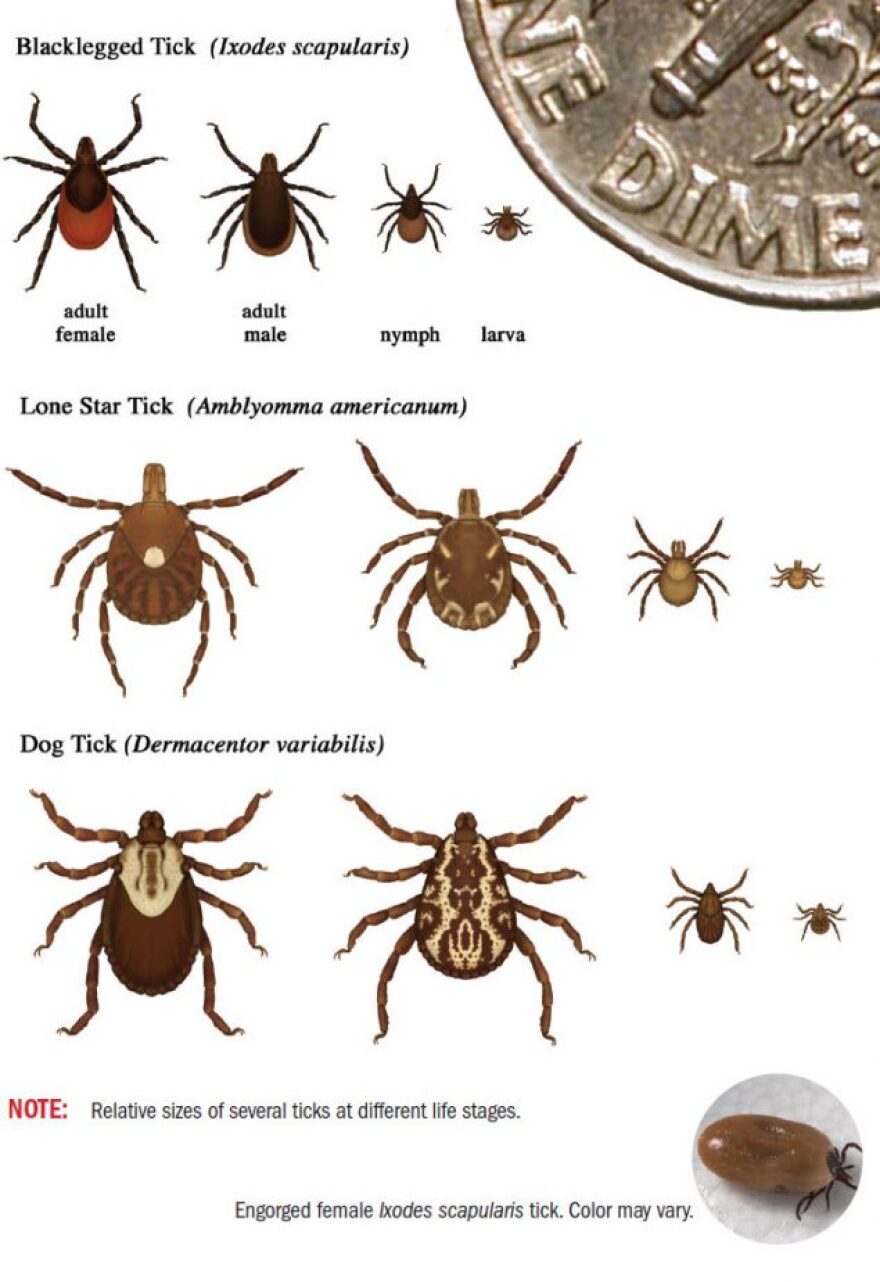Editor's note: This series was originally produced in May 2020 by Taylor Quimby, host of the NHPR podcast Patient Zero. We're republishing it with some small updates. You can also find advice on how to avoid being bitten by a tick here.
There are three things to remind yourself when you’ve been bitten.
- Not all species of ticks carry Lyme disease.
- Of the species that do, not all of them are infected.
- Even when they are infected, most tick-borne diseases take about 24 hours or longer to transmit disease (the rare but frightening Powassan Virus being an exception).
So if you happen to find a tick burrowed in your skin, the first thing to do is not to panic - it's to calmly remove it as fast as possible.
Remove the tick
Eric Foster, a medical entomologist with the CDC, says removing ticks is a simple process that shouldn’t involve any of the unusual methods you may stumble into online.
“We don’t recommend that people use a match or cover it with petroleum jelly or anything like that," explained Foster.
Funny story: Many years ago, I once tried both of these things with a tick that was embedded in my chest. I wound up with a mild burn and a moisturized tick that was still stuck inside my skin. Don’t be like me. Use tweezers or fine-toothed forceps (which are basically tweezers).
Dr. Kaitlyn Morse, Executive Director of BeBop Laps, a non-profit that tracks infected ticks in New Hampshire, has this advice on how to get the job done:
"Do it as fast as possible, and pull it straight out. No twisting, no freak out moments.”
If the head of the tick (technically called “the mouthparts") gets stuck inside, don’t fret: it shouldn't increase your risk of disease, though it can be uncomfortable - the equivalent of a splinter.
After you’ve gotten the tick out, wash the site thoroughly to avoid irritation.
Identify the tick
Because not all ticks carry disease, it’s important to know the ticks that live in your region so you can identify them when necessary.
Here in New Hampshire, the vast majority of ticks are either dog ticks, or black-legged ticks (also called deer ticks). Dog ticks can carry Rocky Mountain Spotted Fever (RMSF), but because RMSF is quite rare in New Hampshire, the tick of primary concern here is the black-legged tick. Black-legged ticks can carry Lyme disease, the most common vector-borne disease in the country, as well as Anaplasmosis and Babesiosis.
A visual guide can help you differentiate tick species, but because of their different life stages and relatively small size, identification can be tricky.
“If there’s any white on them,” Dr. Morse says, “you've found a dog tick. If there’s any red on them, you’ve found a black-legged tick. Although that’s only the female.”

Trickiest of all are the nyphs, which are only the size of a poppy-seed, and have fewer identifying features. If you’re not sure what kind of tick has bitten you, there are a few resources that can help.
Researchers at Columbia University, with funding from the CDC, have developed a free app that allows you to take a picture of your tick with a smartphone.
The Tick App will then help you identify the tick and estimate how long it may have been embedded in your skin, which is an important factor when understanding your risk of contracting a tick-borne illness.
The Tick App, however, can’t tell you whether the tick you pulled out is infected with the bacteria that causes Lyme disease or any other pathogens.
For a fee, commercial labs like Ticknology and The Tick Report can identify your tick, test your tick, and give you clues about how long it’s been embedded.
For Granite Staters who find unattached ticks crawling on your skin, or that of your dog or other pet, they can also mail them to Kaitlyn Morse at Bebop Labs to add to her growing pool of tick data.

Monitor for symptoms
Most of the time, a tick bite does not by itself warrant a prophylactic dose of antibiotics, the typical treatment for Lyme disease.
The CDC only recommends a single prophylactic dose of doxycycline for black-legged tick bites if the tick's body appears to be engorged with blood (not flat) which is an indication it's been hanging on there for awhile.
For shorter-duration bites, the low risk of infection doesn’t justify the side effects of the medicine.
But even if the risk isn’t high enough for a pre-emptive strike, it is wise to remain vigilant.
The CDC’s Erik Foster says, “Save that tick and watch for symptoms. Keep an eye out for fever, or body aches. Any kind of joint pains, any kind of rash. And if any of those happen to you after a tick bite, within a couple weeks, it would be really important to see your health care provider immediately.”
In summary, the three steps to take if you find a tick embedded in your skin are:
- Calmly remove the tick
- Identify the tick (and optionally, have it tested)
- Save the tick, and monitor for symptoms
And although it’s easier said than done, try not to panic. As someone once told me, the ticks you find aren’t the problem: it’s the ticks you don’t find that you should be really scared of.
To learn more about Lyme disease, listen to more Patient Zero - you’ll find it wherever you get your podcasts.








